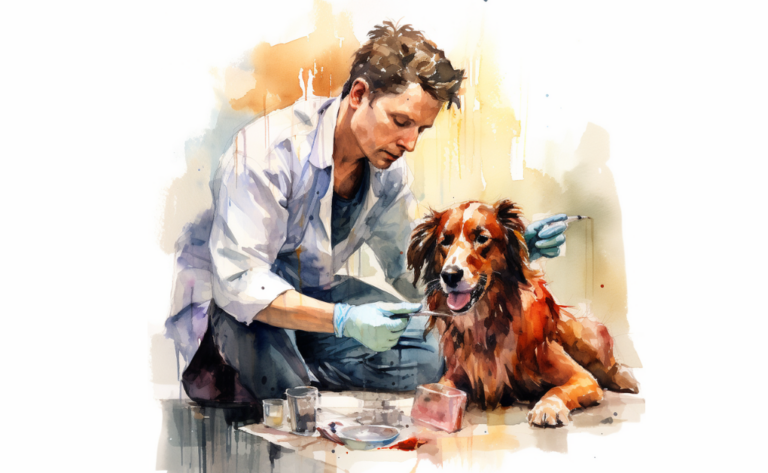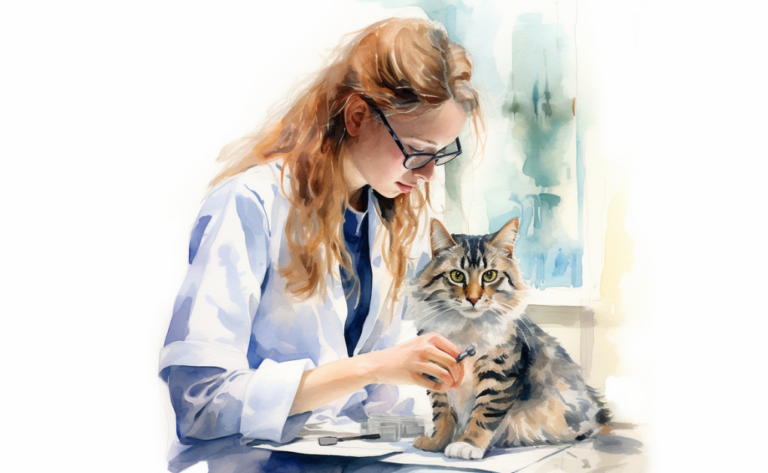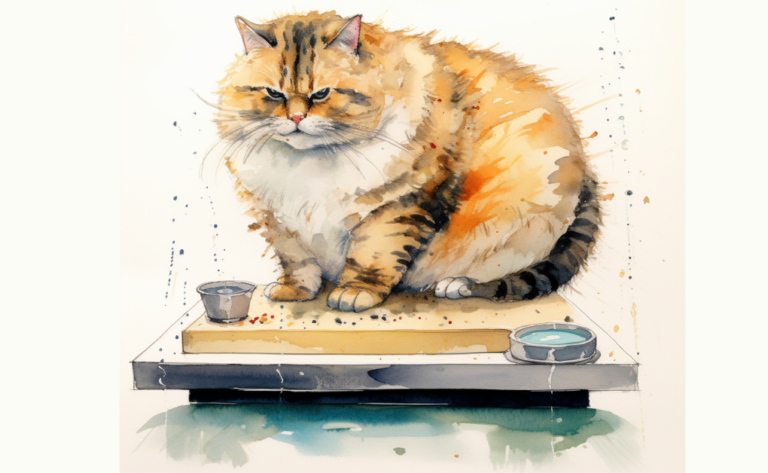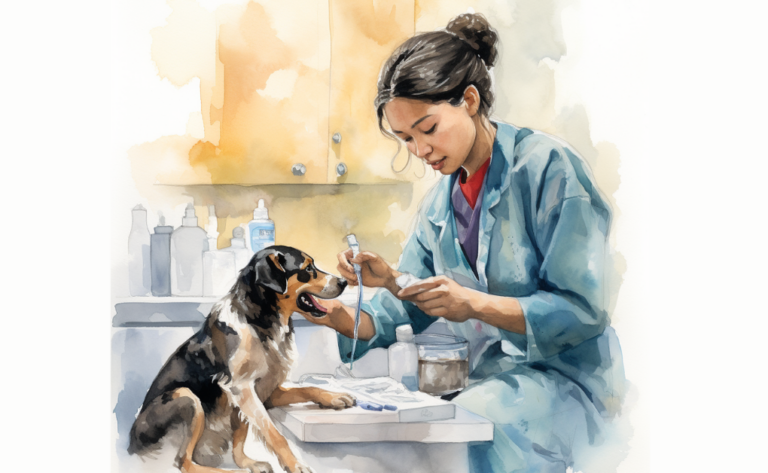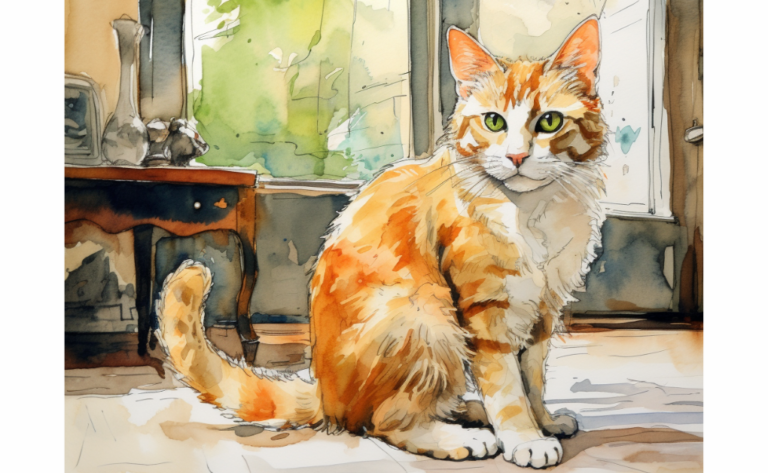What are Food Allergies in Cats
What is it?
How is it Treated?
Breed Predispositions
Any cat can develop a food allergy, and the specific allergen can vary widely among individuals.
Introduction
After switching to a new brand of cat food, Anna noticed that her affectionate Ragdoll cat, Luna, started experiencing gastrointestinal issues and excessive itching. Concerned about Luna’s sudden discomfort, she sought advice from her veterinarian, who suggested that Luna might be suffering from food allergies.
Food allergies in cats occur when the feline’s immune system overreacts to a particular ingredient present in its diet. These allergies are unfavorable food reactions where the immune system incorrectly identifies a typically innocuous food protein as a threat, instigating an immune response. It’s important to distinguish this response from food sensitivity or food intolerance, which doesn’t involve an immune system reaction and is generally connected to the inability to digest a specific food or component.
Though rare in cats, especially young cats, food allergies can be effectively managed with the right dietary adjustments and veterinary care to ensure the cat’s well-being. Identifying the offending allergen, which could even be a flea allergy, is crucial to control the adverse reaction and discern whether the cat has an allergy.
Classifications of Allergies in Cats
Allergies are classified into four types based on how the immune system reacts to the antigen:
Type I Hypersensitivity Reactions
Type I hypersensitivity reactions, also known as immediate hypersensitivity reactions, occur when a cat’s immune system reacts excessively to a foreign substance or allergen. Regarding cat food allergies, this allergen is typically a protein found in the cat’s diet.
Upon first exposure to the allergen, the cat’s immune system produces a specific type of antibody called Immunoglobulin E (IgE). These IgE antibodies bind to mast cells, a type of immune cell. When the cat is exposed to the same allergen again, it binds to the IgE antibodies on the mast cells, triggering them to release inflammatory substances such as histamine.
This histamine release leads to the various symptoms associated with an allergic reaction. In the case of a food allergy, these symptoms may manifest primarily in the skin or gastrointestinal tract but can also affect other systems.
Type II Hypersensitivity Reactions
Type II hypersensitivity, or cytotoxic hypersensitivity, is a reaction where the immune system erroneously targets the body’s cells. This typically occurs when antibodies the immune system produces bind to antigens on the body’s cells, marking them for destruction.
However, Type II hypersensitivity reactions are not usually involved in the context of food allergies in cats. Food allergies in cats are generally thought to be related to Type I hypersensitivity reactions, where the immune system reacts to an allergen (typically a protein in the diet) rather than to the body’s cells. Other types of immune responses, like Type III and IV hypersensitivity reactions, might also be involved in cat food allergies.
Type II hypersensitivity reactions are more typically associated with conditions like autoimmune diseases, where the immune system attacks the body’s cells, rather than allergies, where the immune system reacts to a foreign substance. However, understanding food allergies and their exact mechanisms in cats is still a subject of ongoing research.
Type III Hypersensitivity Reactions
Type III hypersensitivity, also known as immune complex hypersensitivity, involves forming immune complexes, clusters of antigens (foreign substances) and antibodies that can deposit in various tissues and trigger an inflammatory response. This type of hypersensitivity reaction is often associated with autoimmune diseases and certain infections.
However, in the context of cat food allergies, the role of Type III hypersensitivity needs to be better defined. Food allergies in cats are typically thought to be associated more with Type I hypersensitivity reactions, where the immune system overreacts to an allergen, usually a protein in the cat’s diet.
It’s important to note that the exact immunological mechanisms underlying cat food allergies are still a subject of ongoing research. Type III hypersensitivity reactions could play a role, but further studies are needed to understand their involvement fully.
Type IV Hypersensitivity Reactions
Type IV hypersensitivity, also known as delayed-type hypersensitivity, is a form of immune response mediated by T-cells, a type of white blood cell, rather than by antibodies. This reaction generally takes 48 to 72 hours, hence the term “delayed-type.” It’s typically associated with reactions to certain drugs, contact dermatitis, and infections.
Regarding cat food allergies, it’s currently unclear how much Type IV hypersensitivity plays a part. Food allergies in cats are often linked to Type I hypersensitivity reactions, where the immune system overreacts to a specific allergen, usually a protein in the cat’s diet.
The immunological mechanisms underlying cat food allergies are still being studied and better understood. Type IV hypersensitivity reactions and other types of immune responses could have a role in these allergies. More research is needed to elucidate their involvement fully.
Causes of Food Allergy in Felines
Various factors can trigger cat food allergies, although the exact cause is often hard to determine. Here are some potential triggers and factors involved:
Protein Sources and Food Intolerance
Most adverse food reactions in cats, including food allergies, are caused by proteins in their diet. This could be from wet or dry food, but certain proteins, such as those found in beef, chicken, fish, and dairy products, are more prevalent culprits. This is likely because these protein sources are commonly included in cat food, leading to overexposure. Sometimes, the issue might be a food intolerance rather than a true allergy.

Genetic Predisposition and Seasonal Allergy
Like humans, some cats have a genetic predisposition to allergies, which can also influence seasonal and food allergies. Cats with such predispositions have an overactive immune system that reacts to harmless substances, like certain food proteins or environmental allergens.
Repeated Exposure to an Allergen and Atopic Dermatitis
If a cat is repeatedly exposed to a particular food protein, it could start recognizing it as a threat, leading to an allergic reaction. This means a cat could develop an allergy to food it has been eating without issue for years. Repeated exposure can also lead to atopic dermatitis, a chronic skin disease associated with allergies.
Age
Food allergies can occur at any age, often in cats under a year old. This is possibly due to the immature immune system of kittens, which can overreact to new substances. However, mature cats can also develop food allergies, especially if their diet changes or if they develop a flea bite allergy, which can also involve an immune reaction.
Preservatives and Colorings
Some cats may react to artificial additives like preservatives and colorings, although this cause is much less common than protein allergies. These synthetic ingredients can trigger an immune response, leading to allergy symptoms.
Gastrointestinal Conditions
Cats with gastrointestinal issues like inflammatory bowel disease (IBD) can be more susceptible to food allergies. Inflammatory conditions like IBD increase the gut’s permeability, allowing larger, undigested food particles to enter the bloodstream and trigger an allergic reaction.
Remember, seeking professional advice from a vet is crucial if you believe your cat has a food allergy. They can provide appropriate testing and treatment options to help manage your cat’s symptoms and improve their quality of life.
Cat Food Allergy Symptoms
Skin allergies are also caused by food proteins that irritate the cat’s itchy skin condition. These allergens can trigger rashes, hives, and other reactions.
Cats with food allergies can exhibit a range of symptoms. Some of the most common include:
Dermatological Symptoms:
- Persistent scratching, biting, or licking of the skin
- Redness, rashes, or bumps on the skin
- Hair loss, often due to excessive grooming
- Swelling of the face, paws, or other body parts
- Sores or scabs on the skin
Gastrointestinal Symptoms:
- Vomiting
- Diarrhea
- Increased frequency of bowel movements
- Changes in appetite
In addition, digestive system problems can result in an estimated 10% to 15% of affected cats may also exhibit gastrointestinal signs, including vomiting and diarrhea.
Respiratory Symptoms:
- Coughing or wheezing
- Difficulty breathing (less common)
Behavioral Symptoms:
- Increased grooming behavior
- Restlessness or changes in behavior due to discomfort
It’s important to note that these symptoms can also be associated with other health issues, not just food allergies. Therefore, seeking veterinary care is essential if your cat is experiencing these symptoms. A vet can help determine the cause of the symptoms and recommend appropriate treatment.
Diagnosis of Cat Food Allergies
Vets use various methods to diagnose cat food allergies, and it’s often a complex process requiring much patience. The journey often begins with an extensive review of the cat’s medical history and a physical examination before moving on to more targeted diagnostic techniques:
Food Trial
The food trial involving a novel protein is the most reliable method and is much more common for diagnosing cat food allergies. In this process, the cat is fed a novel protein source, a type of protein the cat hasn’t eaten before, for 8 to 12 weeks. During this period, no other food or treats are given to the cat. If symptoms improve during this trial, the cat may be allergic to an ingredient in their original diet. To confirm, the original diet is reintroduced. If symptoms reappear, a food allergy is confirmed. If you’re worried your cat may have food allergies, starting with a food trial is a good step.
Blood Tests
Blood tests are available for cat food allergies but are less reliable and often produce false-positive results. These tests measure the level of immunoglobulin E (IgE) antibodies in response to specific food proteins. Increased IgE levels may indicate an allergic response. Despite this, the correlation between the test results and clinical symptoms could be better, so this method is not recommended as the only diagnostic tool.
Skin Testing
While skin testing, also known as intradermal allergy testing, can be used, it is much more common in diagnosing inhalants rather than food allergies. Small amounts of common allergens are injected into the skin during this process. A localized reaction will occur if the cat is allergic to a specific substance.
Fecal Exam
A fecal exam can rule out other causes of gastrointestinal symptoms, such as intestinal parasites, providing further information on food allergies in your cat.
Additional Diagnostic Tests
Other tests like a blood chemistry profile, complete blood count, and urinalysis may be carried out to rule out other health issues that might cause similar symptoms to food allergies.
Allergies occur in cats like humans, and cats can develop an allergy at any stage. If you’re worried that your cat may have food allergies, it’s best to consult with a veterinary nutritionist or your regular vet. Diagnosing food allergies can be difficult, and even with a well-conducted food trial, some cases may remain uncertain. In such instances, managing the cat’s diet may need to continue on a trial-and-error basis.
Treatment Options for Food Allergy in Cats

Treating cat food allergies typically involves several strategies to alleviate the immediate symptoms and prevent future allergic reactions. Here are some of the most common treatment options:
Dietary Management
This is the starting treatment for food allergies in cats. If a specific allergenic food ingredient is identified, it’s eliminated from the cat’s diet. This approach is often referred to as an elimination diet. Many commercial pet food companies like Purina offer hypoallergenic diets. These diets contain either hydrolyzed proteins (proteins broken down into tiny pieces that won’t trigger an allergic reaction) or novel proteins (protein sources the cat has never been exposed to before, reducing the likelihood of an allergic reaction).
Elimination of Allergenic Treats
Like their main food, any cat treats containing the allergenic ingredient should be removed from the cat’s diet. It’s crucial to consider all potential allergen sources, including cat treats and certain cat care products.
Sometimes, a vet might prescribe antihistamines to help control the allergic reaction. These function by blocking histamines, the chemicals in the body that trigger allergy symptoms. Antihistamines can help control itching and other allergic symptoms, but they’re typically only a part of a more comprehensive treatment plan.
Corticosteroids
Corticosteroids may be required for short-term use if the allergic reaction is severe. They quickly reduce inflammation and itching. However, these medications can have significant side effects, especially with long-term use, so they’re generally used as a last resort when other treatments aren’t effective.
Immunotherapy
If a specific allergen has been identified and can’t be avoided, such as an environmental allergy causing a food reaction, immunotherapy (allergy shots or oral drops) could be an option. This approach involves gradually exposing the cat to increasing amounts of the allergen to desensitize the immune system.
Probiotics
Emerging research suggests that probiotics could help manage food allergies by supporting gut health. Probiotics assist in maintaining a healthy balance of bacteria in the gut, which could support the immune system and potentially reduce the overreactive response to certain food allergens.
Bear in mind; every cat is unique. What works for one may not work for another. A personalized treatment plan should match each cat’s needs and lifestyle. Working closely with your vet is crucial, as managing food allergies often requires ongoing adjustments and monitoring of the treatment plan.
Prevention of Feline Food Allergy
Preventing cat food allergies can be challenging because there’s no guaranteed method to ensure your cat will never develop an allergy. However, there are some steps you can take to reduce the risk or delay the onset of food allergies:
- Diet Diversity from an Early Age: Feeding kittens a diverse range of foods can help their bodies learn to tolerate different proteins and ingredients. Introducing a variety of textures and types of food (such as wet food, dry food, and raw food) can help prevent your cat from becoming overly sensitive to one particular type of food.
- Avoid Overfeeding Certain Proteins: Overexposure to certain proteins, particularly beef, dairy products, and fish, has been linked to cat food allergies. Rotating protein sources or feeding a diet with multiple protein sources can help reduce the risk.
- High-Quality Diet: Feed your cat a high-quality, balanced diet appropriate for their life stage. These diets are typically designed to provide the optimal balance of nutrients, supporting your cat’s overall health and immune system and making them less susceptible to developing allergies.
- Monitor for Signs of Allergies: Watch your cat for signs of allergies, such as excessive scratching, redness, vomiting, or diarrhea. If you notice these signs, consult with your vet. If you catch allergies early, you can avoid a prolonged inflammatory response, which could reduce your cat’s sensitivity.
- Slow Introduction of New Foods: When introducing a new food, do it gradually over a week, mixing increasing amounts of the new food with the old. This slow introduction can help you identify any adverse reactions before they become serious.
- Avoid Foods with Artificial Additives: Some cats may be sensitive to artificial colors, flavors, or preservatives. Feeding a diet free from these additives might reduce the chance of developing an allergy.
Remember, each cat is an individual, and what works for one cat may not work for another. Always consult your vet about your cat’s diet to ensure it is balanced and suitable for their age, breed, and health status.
Frequently Asked Questions
Disclaimer: The information provided on this veterinary website is intended for general educational purposes only and should not be considered as a substitute for professional veterinary advice, diagnosis, or treatment. Always consult a licensed veterinarian for any concerns or questions regarding the health and well-being of your pet. This website does not claim to cover every possible situation or provide exhaustive knowledge on the subjects presented. The owners and contributors of this website are not responsible for any harm or loss that may result from the use or misuse of the information provided herein.



